
Alessandro di Mariano di Vanni Filipepi, better known as Sandro Botticelli or simply Botticelli, was an Italian painter of the Early Renaissance. Botticelli's posthumous reputation suffered until the late 19th century, when he was rediscovered by the Pre-Raphaelites who stimulated a reappraisal of his work. Since then, his paintings have been seen to represent the linear grace of late Italian Gothic and some Early Renaissance painting, even though they date from the latter half of the Italian Renaissance period.

Andrea del Castagno or Andrea di Bartolo di Bargilla was an Italian Renaissance painter in Florence, influenced chiefly by Masaccio and Giotto di Bondone. His works include frescoes in Sant'Apollonia in Florence and the painted equestrian monument of Niccolò da Tolentino (1456) in Florence Cathedral. He in turn influenced the Ferrarese school of Cosmè Tura, Francesco del Cossa and Ercole de' Roberti.

Luca Signorelli was an Italian Renaissance painter from Cortona, in Tuscany, who was noted in particular for his ability as a draftsman and his use of foreshortening. His massive frescos of the Last Judgment (1499–1503) in Orvieto Cathedral are considered his masterpiece.
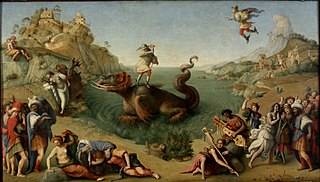
Piero di Cosimo, also known as Piero di Lorenzo, was an Italian Renaissance painter, who continued to use an essentially Early Renaissance style into the 16th century.
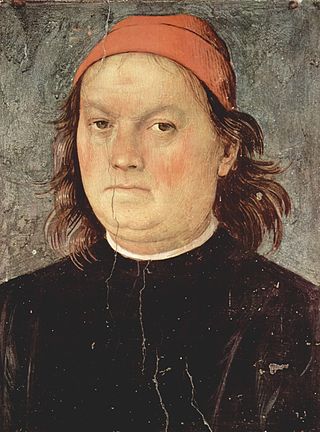
Pietro Perugino, an Italian Renaissance painter of the Umbrian school, developed some of the qualities that found classic expression in the High Renaissance. Raphael became his most famous pupil.
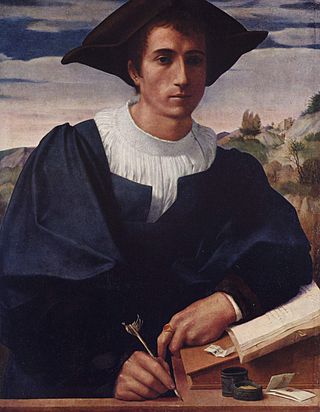
Franciabigio was an Italian painter of the Florentine Renaissance. His true name may have been Francesco di Cristofano; he is also referred to as either Marcantonio Franciabigio or Francia Bigio.

Lorenzo di Credi was an Italian Renaissance painter and sculptor best known for his paintings of religious subjects, and portraits. With some excursions to nearby cities, his whole life was spent in Florence. He is most famous for having worked in the studio of Andrea del Verrocchio at the same time as the young Leonardo da Vinci, who seems to have influenced his style considerably.
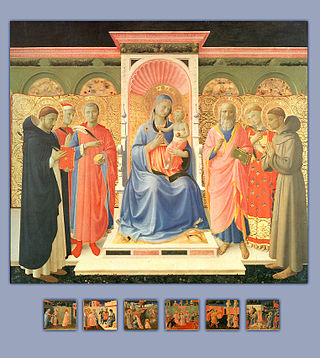
In art, a sacra conversazione, meaning "holy conversation", is a genre developed in Italian Renaissance painting, with a depiction of the Virgin and Child amidst a group of saints in a relatively informal grouping, as opposed to the more rigid and hierarchical compositions of earlier periods. Donor portraits may also be included, generally kneeling, often their patron saint is presenting them to the Virgin, and angels are frequently in attendance.
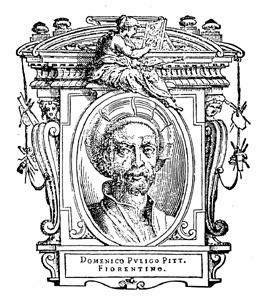
Domenico Puligo (1492–1527) was an Italian painter of the Renaissance, active in Florence. His real name was Domenico di Bartolomeo Ubaldini.
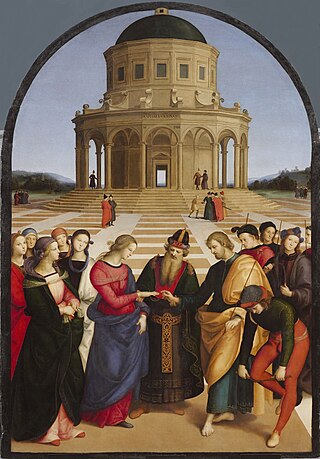
Italian Renaissance painting is the painting of the period beginning in the late 13th century and flourishing from the early 15th to late 16th centuries, occurring in the Italian Peninsula, which was at that time divided into many political states, some independent but others controlled by external powers. The painters of Renaissance Italy, although often attached to particular courts and with loyalties to particular towns, nonetheless wandered the length and breadth of Italy, often occupying a diplomatic status and disseminating artistic and philosophical ideas.

The Madonna of the Magnificat, is a painting of circular or tondo form by the Italian Renaissance painter Sandro Botticelli. It is also referred to as the Virgin and Child with Five Angels. In the tondo, we see the Virgin Mary writing the Magnificat with her right hand, with a pomegranate in her left, as two angels crown her with the Christ child on her lap. It is now in the galleries of the Uffizi, in Florence.

The Madonna and Child with Six Saints, also known as Sant'Ambrogio Altarpiece, is a painting by the Italian Renaissance master Sandro Botticelli, finished around 1470. It is housed in the Galleria degli Uffizi, in Florence.

Andrea del Sarto was an Italian painter from Florence, whose career flourished during the High Renaissance and early Mannerism. He was known as an outstanding fresco decorator, painter of altarpieces, portraitist, draughtsman, and colorist. Although highly regarded during his lifetime as an artist senza errori, his renown was eclipsed after his death by that of his contemporaries Leonardo da Vinci, Michelangelo, and Raphael.
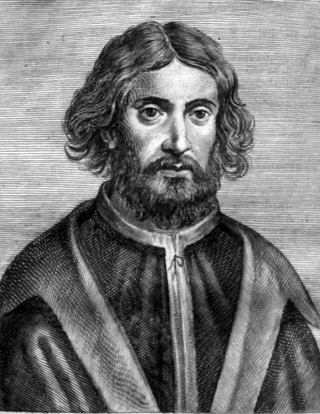
Palma Vecchio, born Jacopo Palma, also known as Jacopo Negretti, was a Venetian painter of the Italian High Renaissance. He is called Palma Vecchio in English and Palma il Vecchio in Italian to distinguish him from Palma il Giovane, his great-nephew, who was also a painter.

The Santa Lucia de' Magnoli Altarpiece is a painting by the Italian painter Domenico Veneziano, dated to around 1445–1447. Once placed at the high altar of the church of Santa Lucia dei Magnoli, Florence, it is now in the Uffizi Gallery in the same city. The large panel had originally a predella, which has been divided between museums in Washington, Berlin and Cambridge.
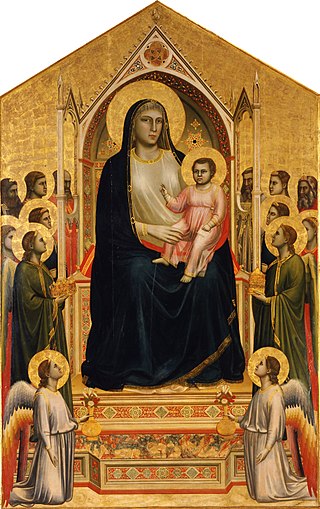
Madonna Enthroned, also known as the Ognissanti Madonna or Madonna Ognissanti, is a painting in tempera on wood panel by the Italian late medieval artist Giotto di Bondone, now in the Uffizi Gallery of Florence, Italy.

The Madonna and Child Enthroned with Saints John the Baptist and Sebastian is a painting by the Italian Renaissance artist Pietro Perugino, executed in 1493 and housed in the Uffizi Gallery, Florence.

The Madonna and Child with St. John the Baptist and a Female Saint or the Giovanelli Sacred Conversation is an oil painting on panel by the Italian Renaissance master Giovanni Bellini, dated to before 1504. It is kept in the Gallerie dell'Accademia of Venice.

The Disputation on the Trinity is an oil-on-canvas painting by the Italian Renaissance artist Andrea del Sarto, created c. 1517, now in the Galleria Palatina in Florence.

Madonna and Child with Eight Saints is an oil painting on canvas of c. 1515–1520 by the Italian Renaissance painter and architect Bramantino, originally in the church of Santa Maria del Giardino in Milan and now in the Contini Bonacossi collection at the Uffizi in Florence. It belongs to the sacra conversazione genre.




















